DGUV V3 inspection: a challenge for hospitals
In many countries, the regular inspection of electrical installations and equipment is legally stipulated. This is also the case in Germany, where hospitals must get their systems inspected every three years in accordance with Regulation 3 of the German Social Accident Insurance (DGUV). For many hospitals, this inspection is so complex in terms of time and organization that it is extremely difficult to perform.
In this article, you can read about how the installation of residual current measurement technology from Bender has made the DGUV V3 inspection much easier for a hospital in the German state of Brandenburg. This solution fits also the regular inspection in accordance with IEC 60364-6.
Regular inspection in accordance with DGUV V3 / IEC 60364-6
The German regulation DGUV V3 requires a periodic verification of electrical installations. The audit is associated with a considerable organisational, time and personnel effort in hospitals. This is because devices and systems must be disconnected from the mains for the prescribed insulation test (Riso). During this time, the power supply in the affected areas is interrupted. The DGUV V3 or IEC 60364-6 testing can therefore often only be carried out at night. In addition, the technicians are not available for regular operations during the time of the test.
Due to these conditions, it is very difficult to comply with the prescribed periodic verification of the DGUV V3.
Simplifying the periodic verification with Residual Current Monitoring (RCM)
Those responsible at the University Hospital Brandenburg an der Havel have taken on the problem. After thorough consultation, they decided to have their main building distribution and floor distributions permanently monitored by Residual Current Monitoring technology from Bender. DGUV V3 states that the Riso measurement can be dispensed with for the periodic verification of electrical systems if the systems are continuously maintained by skilled persons, competent in verification and inspected by permanent or continuous metrological measures as part of the operation. The Residual Current Monitoring technology from Bender fully complies with the specifications of the periodic verification in accordance with DGUV V3 and IEC 60364-6 and thus significantly reduces the organisational, time and personnel costs.
How the pilot system brought errors to light
For test purposes, a pilot system with Bender measurement technology was installed in building 3 of the hospital (ward block, eye surgery and kitchen). When this pilot system was commissioned, in one branch the RCM system initially showed a differential current of about 3.5 A, while in all other branches the differential currents were in the one- to two-digit mA range. Initial suspicions of a faulty measurement or a defective measuring device proved to be wrong. After further measurements, an error during installation could also be ruled out. An LED strip light was finally identified as the source of the insulation fault. After replacing the light strip, a differential current in the uncritical low two-digit mA range was also measured on the previously faulty branch.
All buildings will be equipped with Residual Current Monitoring technology
This has completely convinced the customer of Bender measurement technology. Its finding: Without the installation of the residual current measurement technology, the fault caused by the defective LED strip light would never have been noticed. Even the Riso measurement prescribed as part of the periodic verification would not have brought the fault to light.
After the successful test, the hospital extended the project to the entire building 3. The measuring system is scheduled to go into operation in autumn 2023. After that, all other buildings of the University Hospital Brandenburg an der Havel will gradually be equipped with Residual Current Monitoring technology.
5 Benefits of residual current monitoring
The biggest advantage is the time saved by the simplified DGUV V3 inspection. With residual current monitoring from Bender, it is no longer necessary to switch off and disconnect devices and installations for periodic verification. In addition, even the upcoming insulation faults in the electrical installation are now detected and located, so that it is possible to react quickly if, for example, a patient connects a protection class 1 device or a medical device is not working properly. However, there are also other advantages resulting from the installation of residual current monitoring. For example, fire protection is improved because even the smallest electrical insulation faults are detected.
These are the advantages at a glance:
- Significantly lower organisational, time and personnel effort for DGUV V3 and/or IEC 60364-6 testing
- No switching off and disconnecting of electrical installations and equipment
- Fast detection of insulation faults
- More safety through continuous measurement
- Improved fire protection
Measure without switching off
The periodic verification of all electrical installation in accordance with DGUV V3 and IEC 60364-6 involves a considerable amount of organization, time and personnel in hospitals. Permanent residual current monitoring in the main building distributions and floor distributions significantly reduces the effort. Shutdowns and the disconnection of equipment are no longer necessary. This can save hospital operators a lot of money and increase safety at the same time.




